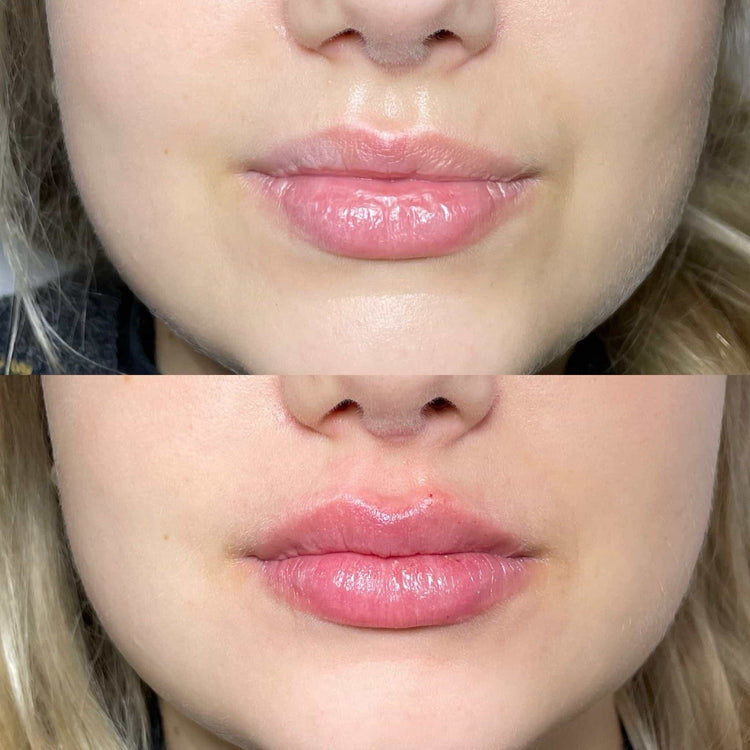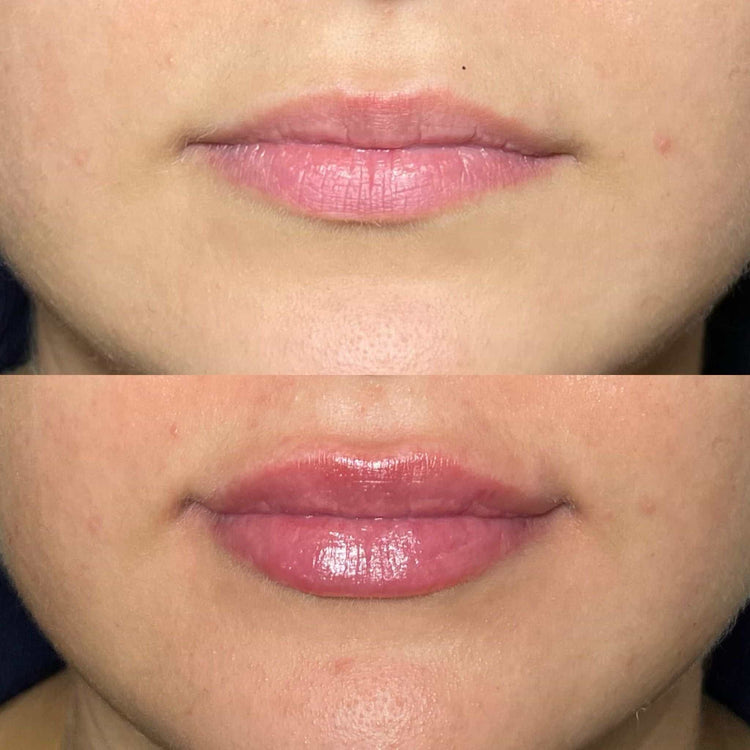Types of Lip Filler Materials
Lip augmentation has become increasingly popular, with many seeking fuller, more defined lips. A key factor in deciding on lip fillers is understanding the various materials available. From hyaluronic acid to poly-L-lactic acid and even collagen, each material offers unique properties that influence longevity and potential for permanency.
Hyaluronic Acid Fillers
Hyaluronic acid is a naturally occurring substance in the body that helps retain moisture and adds volume. When injected into the lips, hyaluronic acid fillers plump up the area, creating a fuller appearance. These fillers are typically temporary, lasting anywhere from 6 to 18 months, depending on the specific product used and individual factors.

Because hyaluronic acid is gradually broken down by the body over time, repeat treatments are necessary to maintain the desired results. However, some newer hyaluronic acid fillers contain stabilizers that can prolong their duration, potentially extending the effects for up to 2 years.
Long-Lasting Synthetic Fillers
While hyaluronic acid fillers are popular due to their natural properties and relatively quick reversal if needed, those seeking long-term options may turn to synthetic materials. Poly-L-lactic acid (PLLA) is a synthetic polymer that stimulates collagen production in the lips. Unlike hyaluronic acid, PLLA doesn’t provide immediate volume but gradually increases lip fullness over several weeks as the body responds to the implant.
PLLA fillers are known for their longer-lasting results, with effects typically lasting 12 months or more. This longevity stems from the fact that PLLA is not absorbed by the body and encourages the production of new collagen, which helps maintain fullness over time.
Longevity of Lip Fillers
The desire for fuller lips has fueled the popularity of lip fillers, but the question of permanency often arises. While some materials offer temporary results, others provide longer-lasting solutions. Understanding the different types of fillers and their longevity is crucial for individuals seeking optimal outcomes.

Hyaluronic Acid Filler Duration
Hyaluronic acid fillers are a popular choice due to their natural properties and relatively quick reversal if needed. They typically last between 6 to 18 months, though newer formulas with stabilizers can extend this duration to up to 2 years.
- Hyaluronic acid is gradually broken down by the body over time, necessitating repeat treatments to maintain results.
- Poly-L-lactic acid (PLLA) offers longer-lasting effects, typically lasting 12 months or more.
Synthetic Filler Lifespan
Poly-L-lactic acid (PLLA) stands out as a synthetic filler with a longer lifespan. Unlike hyaluronic acid which is gradually absorbed by the body, PLLA stimulates collagen production within the lips.
This process leads to gradual volume increase over several weeks and results in longer-lasting effects, typically lasting 12 months or more.
Factors Influencing Filler Lifespan
Numerous factors influence how long lip fillers remain effective. The type of filler material plays a significant role, with hyaluronic acid typically providing shorter-term results compared to synthetic options like poly-L-lactic acid (PLLA). Individual metabolism, lifestyle choices, and the specific techniques used during injection can also affect filler longevity.
Filler Location
The location of lip fillers within the lips also influences their lifespan. Fillers placed in areas with more movement, such as the Cupid’s bow or vermilion border, tend to degrade faster due to constant muscle contractions. Areas with less movement, like the philtrum or deeper parts of the lips, may retain filler for a longer period.
Understanding these factors can help individuals make informed decisions about their lip augmentation goals and choose the most suitable filler type and placement for their desired outcome and longevity.
Individual Metabolism
Individual metabolism significantly influences how long lip fillers last. Faster metabolisms tend to break down filler material more quickly, resulting in shorter-lasting results compared to individuals with slower metabolisms.
Lifestyle factors, such as sun exposure, smoking, and certain medications, can also impact filler longevity. Sun exposure can degrade hyaluronic acid fillers faster, while smoking may hinder collagen production, affecting the effectiveness of PLLA.
Lifestyle Factors
The lifespan of lip fillers is influenced by a combination of factors, including the type of filler used, individual metabolism, lifestyle choices, and injection technique.
Different types of filler materials have varying lifespans. Hyaluronic acid fillers, for example, are generally temporary, lasting anywhere from 6 to 18 months. Poly-L-lactic acid (PLLA) fillers, on the other hand, stimulate collagen production and can provide longer-lasting results, often lasting 12 months or more.
Individual metabolism plays a role in how quickly the body breaks down filler material. Those with faster metabolisms may experience shorter-lasting results compared to individuals with slower metabolisms.
Lifestyle factors can also influence filler longevity. Sun exposure can degrade hyaluronic acid fillers, while smoking may hinder collagen production, affecting the effectiveness of PLLA fillers.

Certain medications, such as retinoids, can also impact filler lifespan by affecting skin turnover and collagen production.
Maintenance and Repeat Treatments
Determining how long lip fillers last is a multi-faceted consideration involving various factors. Understanding these factors is crucial for individuals seeking to achieve their desired lip enhancement goals and understand the duration of their results.
Schedule for Top-Ups
Top-up treatments are necessary for maintaining the fullness achieved with lip fillers, as they gradually break down over time. The frequency of top-ups depends on several factors, including the type of filler used, individual metabolism, lifestyle choices, and the specific area being treated.
Hyaluronic acid fillers, which are temporary, typically require top-up treatments every 6 to 18 months. Newer hyaluronic acid formulas with stabilizers may extend this duration to up to two years.
Poly-L-lactic acid (PLLA) fillers, known for their longer-lasting effects, often require top-up treatments after 12 months or more.
Potential Complications of Repeated Fillers
Maintaining the results of lip fillers involves repeat treatments. How often these top-up treatments are needed depends on the type of filler used and individual factors such as metabolism and lifestyle.
Hyaluronic acid fillers, being temporary, generally require top-ups every 6 to 18 months. Newer hyaluronic acid formulas with stabilizers can potentially extend this duration to up to two years.
Poly-L-lactic acid (PLLA) fillers, due to their longer-lasting effects, often necessitate top-up treatments after 12 months or more.
While lip fillers offer numerous benefits, it’s essential to be aware of potential complications. These can include swelling, bruising, redness, and infection at the injection site. In rare cases, more serious complications like allergic reactions or tissue damage may occur.
It’s crucial to choose a qualified and experienced injector to minimize these risks. Before undergoing any procedure, individuals should discuss their medical history and any concerns they have with their provider.
Conclusion
The decision to pursue lip fillers is a personal one that involves careful consideration of various factors. Understanding the different types of fillers, their longevity, and potential complications is crucial for making informed choices.
- Individuals seeking temporary results may opt for hyaluronic acid fillers, which typically last from 6 to 18 months.
- Those desiring longer-lasting effects might consider poly-L-lactic acid (PLLA) fillers, known for their ability to stimulate collagen production and provide results that can last for 12 months or more.
Ultimately, the best choice depends on individual preferences, desired outcomes, and lifestyle factors. Consulting with a qualified medical professional experienced in lip augmentation can help determine the most suitable filler type and treatment plan for each person’s unique needs.
- Nasolabial Fold Fillers – Marionette Lines Near Ash, Surrey - May 10, 2025
- How To Make THC Soda Stronger Without Overdoing It - May 10, 2025
- Brow Lift Treatment Near Ripley, Surrey - May 9, 2025
